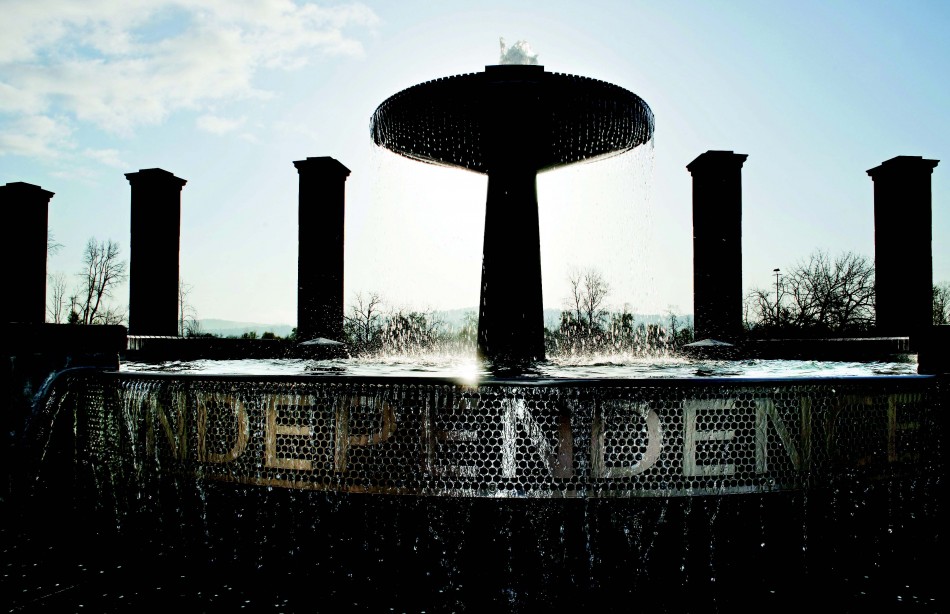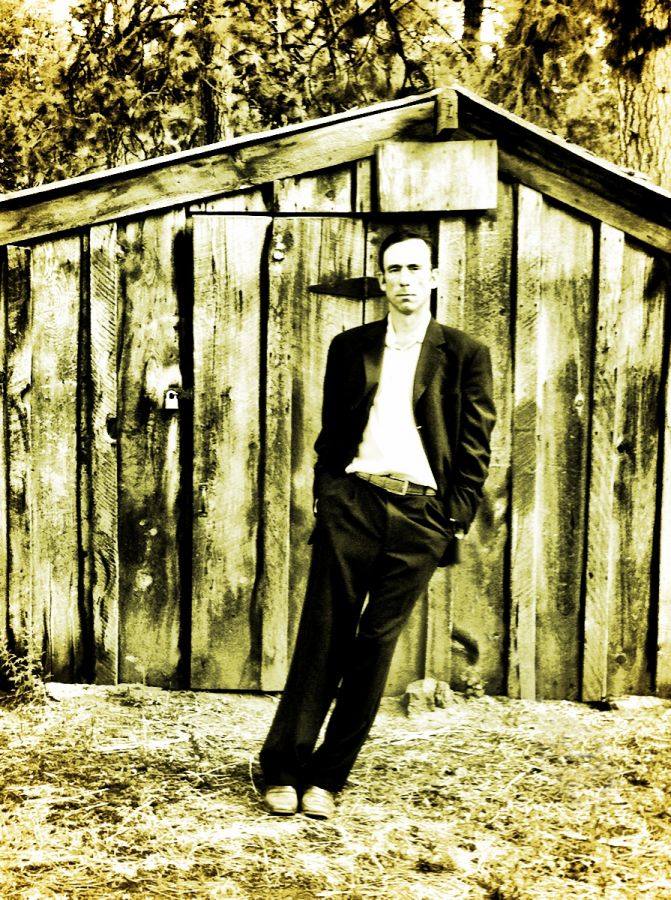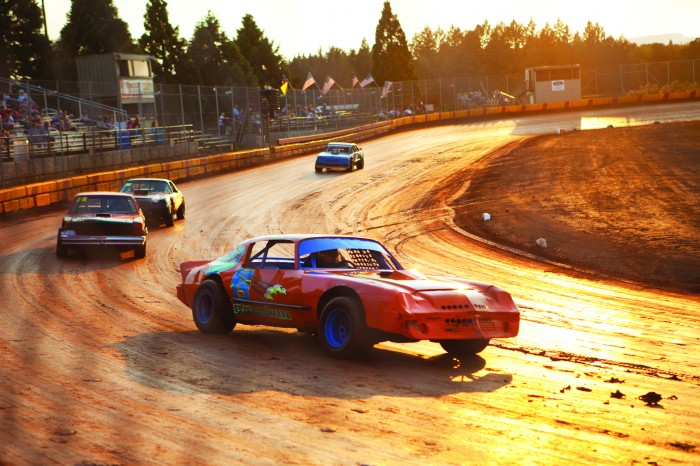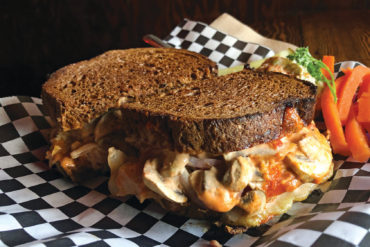written by Max Giffin | photos by Joni Kabana
No less than twice a year, I go grey with humanity. Life gets overly mobile and cellular. The more I connect with people, the more they seem insufficiently sincere. The less I want to engage. Convenience becomes too easy. Alcohol becomes too convenient.
Hemingway called it his “black ass” moments. Shakespeare took all of humanity to the brink of absurdity, saying “Life is a tale told by an idiot,” and so on. I know these symptoms well, and it’s around then that I self-prescribe a dose of nostalgia, old stuff that, today, seems more innocent, durable and essential—less fleeting.
Barbershops—Oregon barbershops—could be my savior this time, though I had no idea of what to expect. Full disclosure, I hadn’t been in a barbershop since I was a kid. I equated barbershops with IBM dress code, the people whose abiding faith motivated them to knock on your door to ask about your relationship with Christ, and large men who spent Saturdays playing softball.
Nonetheless, this is the Nostalgia Super Tour I needed. I plotted four points around the state, with the hope of finding four distinct barbershop cultures, but one common thread—humanity. I know, it all sounds vague and idealistic—desperate even—but think of it as my yoga retreat, my fishing trip, unplugging.

I had recently read about “reminiscence therapy” a new drug-free technique to treat dementia in which home care workers replace their patients’ furniture with vintage furniture, music and photos that harken back to their childhoods. This treatment, “acknowledges a person’s life history and stimulates comforting memories,” a study from a British foundation said. “This can reassure someone with dementia who may feel confused, making them feel more secure.” Sounded like the cure I sought.
In downtown Bend, there are a few barbershops. One of these is L&K, which stands for Lou and Kathy. Inside the small four-chair barbershop, men were caped in black gowns, clippers were buzzing, hair formed pools on the floor around the barber chairs, people talked and read magazines (old-school multitasking) and Dione Warwick crooned directly to me through L&K’s stereo speakers, “What the world needs now, is love, sweet love.” On the walls hung case after case, hundreds of framed belt buckles.
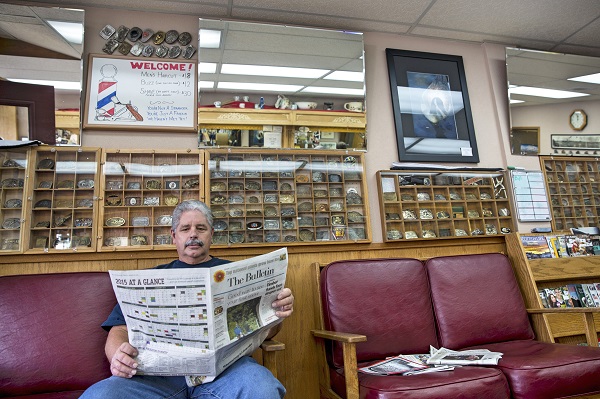
“When you buy a barbershop, you need stuff on the walls,” said L&K owner Claudia Dodson. These buckles were forged with Sisters Rodeo, Smith Tools, Rainier Beer, Olympia Beer, Blitz-Weinhard Beer, NRA and the U.S. Secret Service. I could feel the medicine working its way into my bloodstream as Bobby Darin belted, “Splish splash, I was takin’ a bath.”
Dodson, 63, came to Bend in 1988. Her brother, Lou Bankston and sister-in-law Kathy (the L and K of L&K) needed a barber for the shop he had owned for twenty years at that point. Dodson was making $40 a day in Salem. He promised her $50 a day cutting hair for L&K. She took it.
By then, L&K was well established with regulars since 1968, when Bankston bought the shop. He came about the business in an honest way. He walked in to the existing shop and told the patron that he wanted to buy it. The owner told Bankston he would meet him around the corner at the bar, where he would give him a price when he was done with his client.
So began L&K, but there were problems straight away. Mill workers in the waning lumber economy of Bend equated barbershops with men. A woman barber, Kathy, was a threat to the men’s club. “My brother had knock-down fights right out front because he had a female barber,” Dodson said. “He was a kind of a redneck.” No doubt. It takes a redneck to laugh at a female barber. It takes a bigger redneck to pummel that man.
Dodson invited me into her chair between paying customers. She turned on what appeared to be a half-sized chrome toaster and sounded like a small factory. It was a 1950s-era Oster Stim-U-Lax massage appliance that she strapped around one hand, applied to my back and neck drowning out Frankie Valli’s falsetto, “Shaarree, Sherry bay yay bee.”
That’s Bend. In Eugene, photographer Joni Kabana and I soon gave up our quest for a suitable barbershop and started for Salem. Just before leaving town, we spied a small hut, an island in the middle of a big parking lot. Apartment buildings cast shadows over it. A barber pole spun beneath a red, white and blue awning. An old clock radio on a window sill played country music. The barber’s handlebar moustache put him in a Western-themed barber movie.
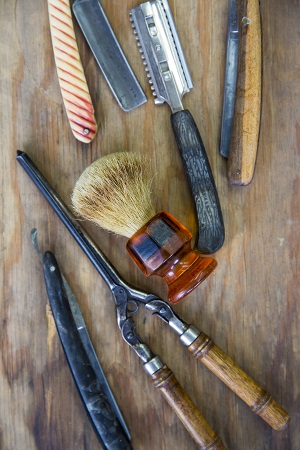
“Urban removal—that’s what I call it,” Larry & Loren’s Barber Shop owner, Larry Owens, bemoaned of urban renewal, as if he knew what I was thinking.
A patron of the barbershop said he had been coming to Larry & Loren’s since 1987. “The shop is the same,” said Mark Losco. “Everything around it has changed.” There was a pawn shop around the corner where, as a kid, he would ogle new arrivals and play blackjack with the owner. He would often detour to the barbershop for a haircut. “Sometimes I think that progress is not a good thing, and I know that this place is solid,” said Losco, an environmental manager for Pacific Recycling, a car shredding firm. “The haircut is good. It’s convenient for me, and you don’t have to make an appointment.”
One recent walk-in was University of Oregon quarterback Marcus Mariotta a week before the National Championship game. Jolan Hill, the other barber at the two-chair barbershop, cut his hair. At some point while cutting Mariotta’s hair, she realized that thirty million people would see her work, so she needed to be on her game. “I just wanted him to feel like a regular customer, so I didn’t ask for his autograph,” she said. “He was very polite and left a nine dollar tip.”
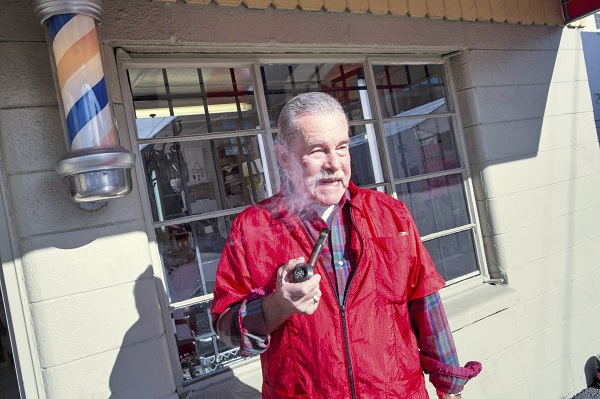
While L&K had a museum of belt buckles, Larry & Loren’s Barber Shop curated a small collection of antique hair trimmers affixed to a ceiling partition overhead. A Wyler Watches clock hung on the wall between the two barber chairs. Owens’ partner in barbering, Loren Carver, received it as a gift in 1955. I suppose it fell to Owens after Carver died. Photos of Owens and Carver from prior barbershops and bootshines were displayed on one wall. In other photos, Owens posed with enormous halibut catches and elk during his annual elk hunt.
When the shop emptied of patrons, Owens stepped outside with another relic. “I’m getting an ear-banging from my wife about pipe smoking,” he declared, firing his pipe and telling us the history of the barber pole. But I was barely listening as the sweet perfume transported me back to childhood, when my dad had his own fling with pipes.
“The barber pole dates back to when barbers were surgeons, pulled teeth, even performed bloodletting …” Owens said, though I caught only pieces of the present discourse while reminiscing in the past.
“The top of the pole was a brass wash basin in which the leeches were kept …” The acrid dried-flower smell filled our house during my dad’s early years as an academic.
“The bottom dish of the pole collected the blood …” It must have been my grandfather’s throat cancer and subsequent laryngectomy that eventually scared Dad back onto cigars.
I’d like to get back to see Owens again before too long. He, and all the others so far, are rolling back my disease, making the present livable with a connection to the past.
On the north edge of downtown Salem, the first thing you notice about Q’s Corner Barbershop is that it’s not on a corner. I never got around to asking Q on which corner he thought his shop was. Writing now, though, it seems obvious.
On an early Wednesday afternoon, Q’s was hopping. This dose of my reminiscent therapy seemed too good to be true. I’ll go back to Salem during regular business hours and verify that “Candy” Q Robertson is real and that this corner barbershop that’s not on a corner is still there. If you go, look for a huge flat-screen TV with a ramped-up cable sports package, a pool table, a mirror hung with boxing gloves, stuffed couches, then close your eyes and listen for basketball banter about the Lakers versus the Trail Blazers between “Smoov” Ivan Gallegos and Candy Q.
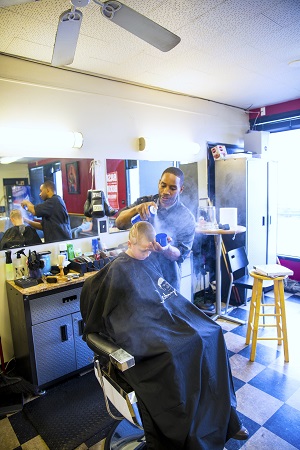
“We have championships,” Gallegos said.
“We have one,” Robertson countered.
“Would you rather have one dollar or many?” Gallegos waxed Socratic.
“Depends on how you got that dollar,” Robertson adeptly slung his Confucian retort.
It turns out that Gallegos was named after Ivan Drago, the robotic Russian boxer from Rocky IV. Gallegos’ brother, Alexis, was named after the great Nicaraguan fighter, Alexis Arguello. “My dad was a boxing fan,” Gallegos said.
In high school, Gallegos began getting his hair cut from Roberston and became a rather steady client. “If I don’t cut my hair every two weeks, I feel dirty,” said the 22 year old. He trained to become a barber and has made Q’s Corner Barbershop his home. “The environment here, I love it,” he said.
Truth is that Robertson is more comfortable talking about boxing than basketball. Robertson was raised by his grandparents as one of eleven kids in Portland. He trained to be a professional boxer and fought as a welterweight on the undercards of Manny Pacquiao and “Sugar” Shane Mosely.
You can take a boxer out of the ring, but you can’t take the ring out of the boxer. “I can change lives cutting hair,” Robertson—ever the showman—threw out, waiting to be challenged. I assume he meant the lives of his nine kids. Maybe the kids from the Boys and Girls Club where he volunteers. I’m not really buying it, though.
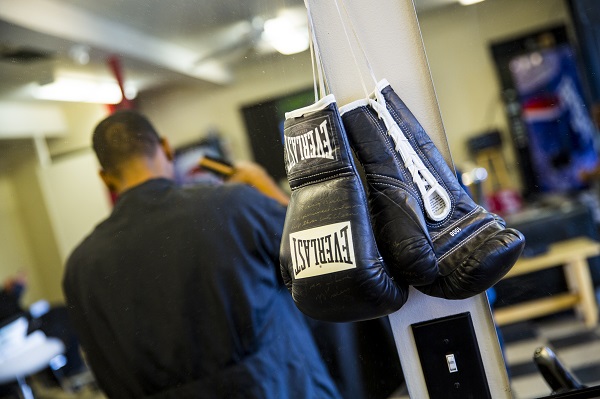
Just then an 8-year-old quietly climbed up into Robertson’s barber chair. His mom had driven him forty-five minutes from Molalla to be in this seat. “He won’t let anyone else touch his hair,” the boy’s mom insisted.
I try to engage the boy as Robertson puts a barber cape on him. “No, he doesn’t talk,” said Robertson. “I know him. He doesn’t talk.” The boy remained silent and stared straight ahead. Robertson produced his phone and pulled up the Seattle Seahawks emblem. With his phone in one hand and clippers in the other, Robertson focused on the side of the boy’s head. He cut precise lines, perfectly round arcs and represented the emblem’s scale perfectly. When he blew the hair shavings from the boy’s scalp ten minutes later, I gaped with the same awe as when I had first approached Mount Rushmore.
I finally understood the zen of Robertson. No matter what, you want Robertson to win in life. You either want him in your corner or to be one of the cornermen in his fight.
The final stop in my four stages of recovery is Portland. I can feel myself getting better, but I know how vulnerable my recovery is to chronic hipsterism, or CH. See your doctor if the symptoms last longer than your first single-speed bike. The hipster movement had always struck me as being nothing more than male models obsessively preening first-generation facial hair while enriching plaid shirt retailers well beyond their plaid economic status. Conversations went as deep as IBUs, IPAs and first single-speed bikes—you know, life. To be fair, many hipsters are now converting to “Lumber-sexuals,” essentially hipsters but with longer facial hair, suspenders and Buffalo plaids. I wondered how a barber could make a living among these dunes of shifting styles.
Compared with my other barber friends, Bart Garmon seemed to be a relative new-comer to the profession. He opened his first shop, Bart’s Barber Shop, on SE Morrison in 1999 and opened his second barbershop in North Portland in early 2015. The latter venue in Portland’s up-and-coming Kenton neighborhood is one of the more stylish settings you will find. It has beautiful blonde wood floors, exposed white bulbs around each of the six mirrors, retro hexagonal tiled entry, vinyl records. On the walls, framed photos and sketches from second-hand shops. I found myself sliding back into skeptical shades of grey.
Then I talked to Garmon, 36. He told me that his parents met in barber college in Ohio, and he grew up in a barbershop. While his parents clipped away, he would draw the front, back and side profiles of the haircut he wanted, and then his mom would cut it to order. His dad, however, would take a look at his drawings and cut his hair the way he thought a barber’s son’s hair should look.
At some point, Garmon began bleaching and cutting his own hair. This irritated his dad to the point of confrontation. “You know why I’m mad, right?” he asked his son. “Because you’re a barber, and I cut my own hair?” Garmon deduced. “’No,’ my dad said, ‘because you clogged my sink!’”
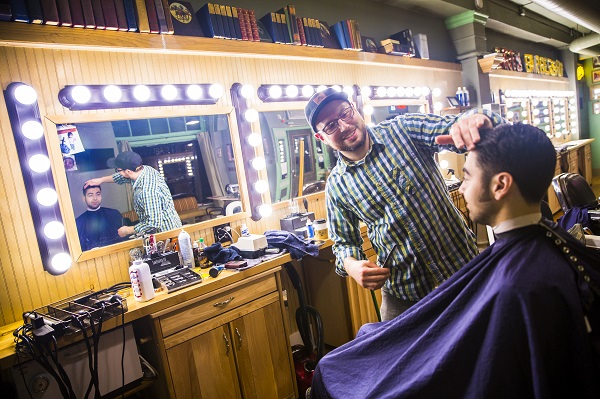
Eventually, Garmon fell in love with Portland and a girl, and got in touch with his roots, barbering. It was in his blood. His four brothers are also barbers. The barbershop on SE Morrison—a classic three-chair storefront shop—is perhaps Portland’s longest-running barbershop in the city, founded in 1928. Garmon began his Portland career there, buying the shop and keeping it true to its authentic roots.
Garmon’s barber at his new venue, Russ London, grabbed a guitar hanging on the wall and played a tune from his band’s repertoire. Seeing my own rough appearance in a mirror, I decided to get my first barber cut since childhood.
As darkness enveloped the North Portland neighborhood at the corner of Denver Ave. and Kilpatrick Street, I walked out of Bart’s Barbershop with a clean cut, a straight-razor shave—refreshed. Light from a second-story space across Kilpatrick caught my eye. A boxer advanced on his sparring partner, throwing combinations and ducking his partner’s cross.



